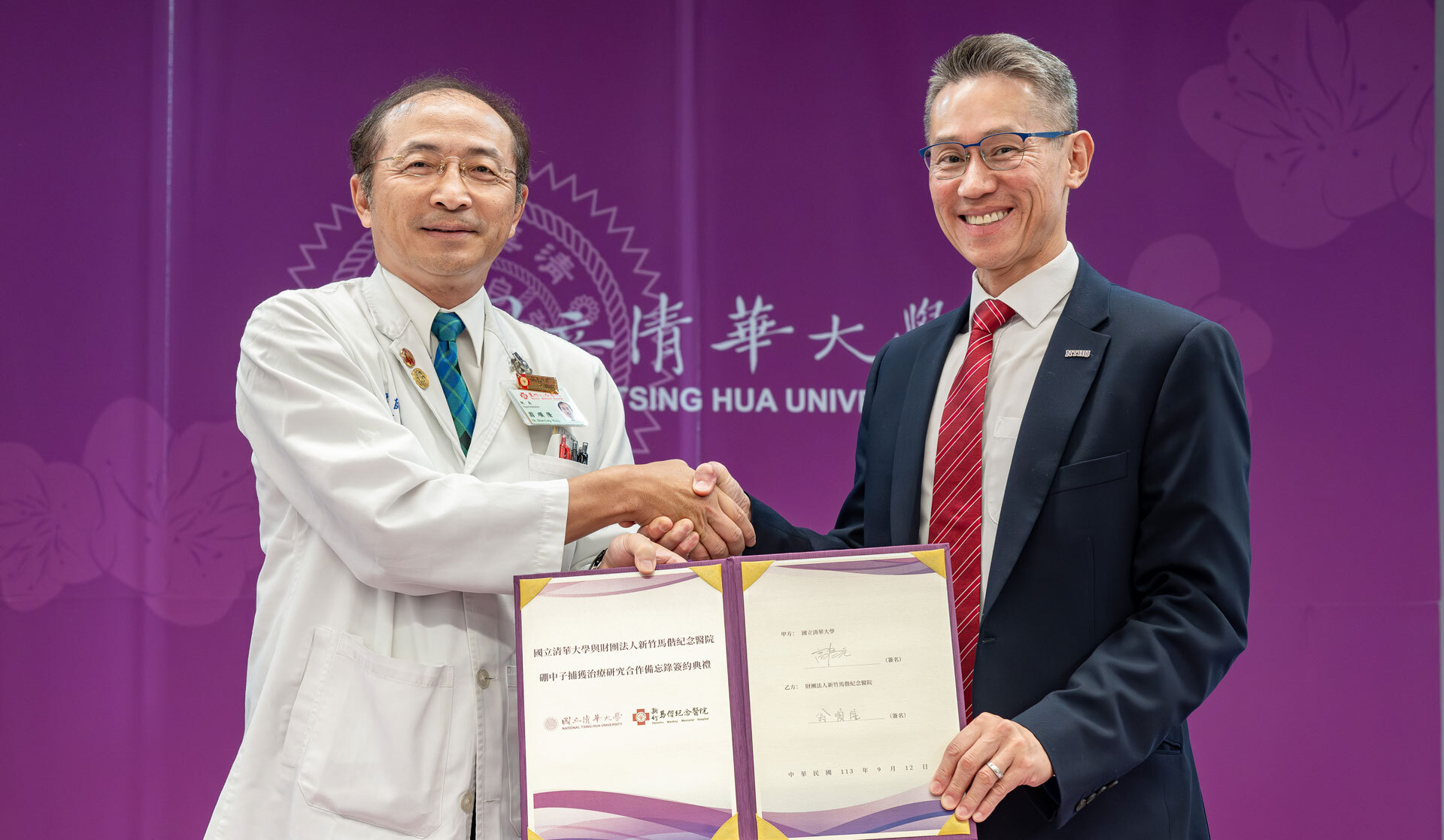A World First! NTHU Teams Up with Mackay Hospital for Conducting Human Trials with BNCT
2024.09.12

NTHU president W. John Kao(高為元) and Hsinchu Mackay Hospital director Shun-Long Weng (翁順隆)displaying the signed memorandum of cooperation.
National Tsing Hua University (NTHU) in Taiwan and the Mackay Memorial Hospital in Hsinchu have recently announced a plan to conduct the world's first human trials using Boron Neutron Capture Therapy (BNCT) to treat liver cancer, bringing a glimmer of hope to patients suffering from diffuse liver tumors and recurring liver cancer.
R.J. Sheu(許榮鈞), director of the Nuclear Science and Technology Development Center (NSTDC) at NTHU, said that BNCT is a kind of targeted radiation therapy in which the patient is injected with a drug containing boron, serving as a target. Once the drug has accumulated in the tumor, a neutron beam is used to irradiate the tumor. This causes the nuclei of the boron atoms to divide, producing alpha particles and lithium nuclei which explode, thereby destroying the cancer cells, without damaging nearby normal cells.
Utilizing a nuclear reactor converted to medical use, NTHU has already treated more than 500 cases of brain tumors and head and neck cancers, including patients from overseas, many of whom suffer from malignant brain tumors that were considered incurable.
The boron-containing drug that is readily absorbed by a liver tumor was developed by a team of researchers at the NSTDC led by Professor Fong-In Chou(周鳳英), known as the “Mother of BNCT.”
After signing the memorandum of cooperation with Hsinchu Mackay Hospital, NTHU president W. John Kao(高為元) said that the launching of clinical trials with humans is a major step forward in developing this technology, and that “it will bring a glimmer of light to liver cancer patients who have lost hope.”
Shun-Long Weng(翁順隆), director of Hsinchu MacKay Memorial Hospital, said that liver cancer often recurs, since a cancerous liver is not longer functioning well, and that even if the tumor is removed, the risk remains. Moreover, the existing treatments for liver cancer aren't very effective, making this cooperative research a new source of hope for liver cancer patients.
Chou said that one of the main challenges in this research has been developing a drug that is readily absorbed by cancerous liver cells but not by normal cells. The boron-containing drug developed by her team for this purpose is called boroncide; it has already been used in animal experiments, but it will take at least another three months for approval from the Ministry of Health and Welfare for use in humans.
Liver cancer ranks second among the top ten causes of cancer death in Taiwan, said Chou, and by the time it is diagnosed, the cancer is often in the final stage. BNCT targets tumors without harming surrounding healthy cells, making it highly suitable for treating multiple or diffuse liver tumors and proliferated vascular tissue.
Wen-Ke Chen(陳文科), a doctor at MacKay Hospital, said that traditional treatments for liver cancer are not very effective and that the cancerous cells tend to return or metastasize. However, BNCT is set to change all that. Chen mentioned the critical situation of a middle-aged woman suffering from recurring liver cancer with a cancer index of 7,000, which is currently untreatable. After hearing about BNCT, she has regained hope and is looking forward to receiving this new treatment as soon as it becomes available.

At the signing ceremony (right to left): Fong-In Chou(周鳳英), R.J. Sheu(許榮鈞), NTHU senior vice president Nyan-Hwa Tai(戴念華), W. John Kao(高為元), Shun-Long Weng(翁順隆), Dr. Shin-Che Chiu(邱世哲), Dr. Wen-Ke Chen(陳文科), and Shi-Mei Xu(徐世美) of the Nursing Department at MacKay.

Fong-In Chou(周鳳英) of the NSTDC at NTHU describing the animal experiments that have already been carried out using boroncide.

W. John Kao(高為元) expects the cooperation between NTHU and MacKay will reduce the number of deaths from liver cancer.

Shun-Long Weng(翁順隆) said that BNCT research at NTHU has given new hope to those suffering from liver cancer.
 NTHU and MacKay personnel at the signing ceremony.
NTHU and MacKay personnel at the signing ceremony.

NTHU's Fong-In Chou(周鳳英) (left) and MacKay's Wen-Ke Chen(陳文科) are preparing to conduct the first ever BNCT clinical trials with humans.

NTHU's Fong-In Chou(周鳳英) (right) and MacKay's Wen-Ke Chen(陳文科) showing where the neutron beam will enter the patient's body.

Wen-Ke Chen(陳文科) (right) with Jinn-Jer Peir(裴晉哲) and Yung-Shin Tseng(曾永信) of the NSTDC at NTHU showing where the neutron beam will enter the patient's body.

Chen (left) with Jinn-Jer Peir(裴晉哲) and Yung-Shin Tseng(曾永信) of the NSTDC at NTHU showing the procedure in which the neutron beam enters the patient's body.

Wen-Ke Chen(陳文科) pinpointing the location where the neutron beam will enter the patient's body in this groundbreaking joint research conducted by NTHU and Mackay Hospital.







